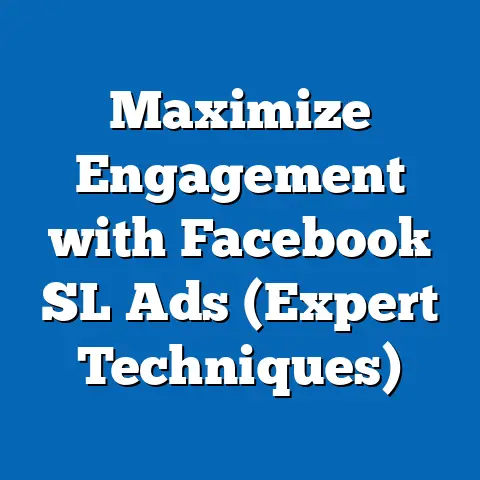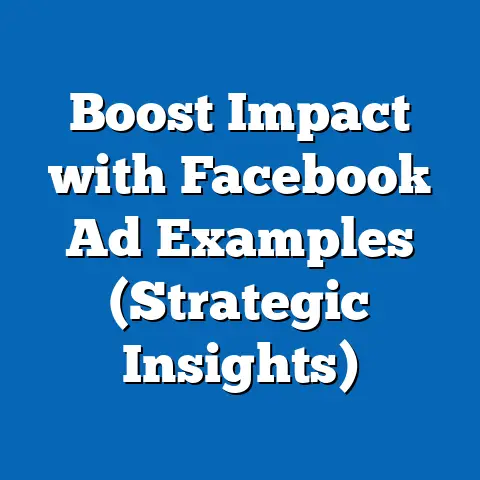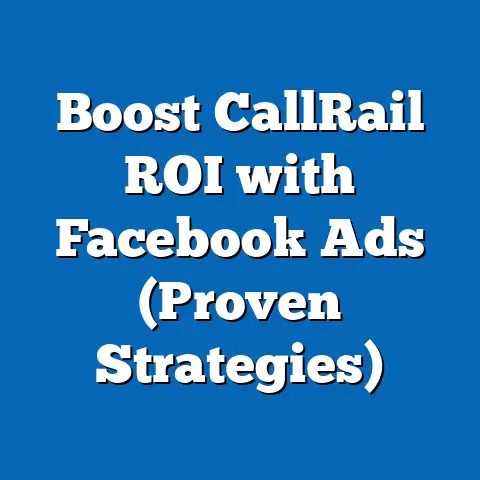Boost Restaurant’s Reach with Facebook Ads (Pro Strategies)
Ignoring the potential of Facebook Ads in today’s digital age could spell disaster for your restaurant’s growth. Let me paint a picture: the aroma of freshly baked bread, the sizzle of a perfectly grilled steak, the vibrant colors of a meticulously crafted cocktail—these are the experiences you offer. But in a world saturated with choices, how do you ensure your delicious offerings reach the right eyes and hungry stomachs? The answer lies in mastering the art of Facebook Advertising.
In the fiercely competitive restaurant industry, simply having a great menu and a cozy ambiance isn’t enough. You need to be proactive in reaching potential customers where they spend a significant portion of their time: on social media. Facebook, with its vast user base and sophisticated targeting capabilities, is no longer just a platform for sharing vacation photos and life updates; it’s a critical battleground for businesses vying for attention and patronage. Leveraging Facebook Ads isn’t optional; it’s an essential ingredient for survival and success in today’s culinary landscape.
Social media marketing, especially on platforms like Facebook, offers unique advantages that traditional advertising methods simply can’t match. You can pinpoint specific demographics, engage with your local community, showcase your unique offerings through visually appealing formats, and, most importantly, drive foot traffic directly to your restaurant.
Understanding the Power of Facebook Ads
Facebook isn’t just a social network; it’s a marketing powerhouse, especially for local businesses like restaurants. Think about it: people are constantly scrolling through their feeds, looking for recommendations, inspiration, and, yes, even their next meal.
Why Facebook Matters for Restaurants:
- Massive User Base: Facebook boasts billions of active users worldwide, and a significant portion of them are actively seeking local businesses. According to Statista, Facebook remains one of the most widely used social media platforms globally, providing an unparalleled reach for your restaurant.
- Local Engagement: People often use Facebook to find nearby restaurants, read reviews, and get recommendations from friends. I’ve seen firsthand how a well-placed Facebook ad can drive a surge of customers through a restaurant’s doors.
- Visual Storytelling: Restaurants thrive on visual appeal. Facebook allows you to showcase your mouthwatering dishes, inviting ambiance, and happy customers through high-quality images and videos.
Key Features That Make Facebook Ads Powerful:
- Audience Targeting: This is where Facebook truly shines. You can target users based on demographics (age, gender, location), interests (food preferences, hobbies), behaviors (dining habits, online activity), and even their connections (friends of people who like your page). I once ran a campaign for an Italian restaurant targeting users within a 5-mile radius who were interested in Italian cuisine and had recently engaged with a competitor’s page. The results were phenomenal, with a significant increase in reservations.
- Ad Formats: Facebook offers a variety of ad formats to suit your needs:
- Image Ads: Simple, yet effective for showcasing a single dish or your restaurant’s exterior.
- Video Ads: Perfect for capturing attention and telling a story. Imagine a short video showcasing your chef preparing a signature dish or highlighting the lively atmosphere of your restaurant.
- Carousel Ads: Allow you to display multiple images or videos in a single ad, ideal for showcasing a range of menu items or different aspects of your restaurant.
- Collection Ads: Designed for mobile users, these ads feature a hero image or video followed by a selection of related products.
- Analytics: Facebook Ads Manager provides detailed insights into your ad performance, allowing you to track key metrics like reach, engagement, and conversions. This data is crucial for optimizing your campaigns and maximizing your ROI.
- Image Ads: Simple, yet effective for showcasing a single dish or your restaurant’s exterior.
- Video Ads: Perfect for capturing attention and telling a story. Imagine a short video showcasing your chef preparing a signature dish or highlighting the lively atmosphere of your restaurant.
- Carousel Ads: Allow you to display multiple images or videos in a single ad, ideal for showcasing a range of menu items or different aspects of your restaurant.
- Collection Ads: Designed for mobile users, these ads feature a hero image or video followed by a selection of related products.
How Facebook Ads Help Your Restaurant:
- Building Brand Awareness: Consistent and targeted ads help you establish your restaurant’s presence in the local market, making it top-of-mind when people are deciding where to eat.
- Increasing Customer Loyalty: Retargeting ads can remind previous customers about your restaurant and encourage them to return. I’ve seen restaurants successfully use retargeting to promote special offers to loyal customers, resulting in a significant boost in repeat business.
- Driving Immediate Sales: Ads promoting limited-time offers, discounts, or special events can drive immediate foot traffic and boost sales.
Takeaway: Facebook Ads are a powerful tool for restaurants of all sizes. By understanding its key features and leveraging its targeting capabilities, you can effectively reach your target audience, build brand awareness, and drive sales.
Setting Up Your Facebook Ads for Success
Before you can start running successful Facebook Ads, you need to lay the groundwork by setting up your account and defining your target audience. This section will guide you through the initial steps to ensure your campaigns are set up for success.
1. Creating a Business Manager Account:
Facebook Business Manager is a central hub for managing all your Facebook marketing activities. It allows you to manage your Facebook Pages, ad accounts, and team members in one place.
- Why it’s important: It keeps your personal and business accounts separate, providing a professional and organized approach to managing your Facebook marketing.
- How to set it up: Go to business.facebook.com and follow the prompts to create a new Business Manager account. You’ll need to provide your business name, email address, and other relevant information.
2. Setting Up and Optimizing Your Facebook Page:
Your Facebook Page is the face of your restaurant on Facebook. It’s where potential customers will learn about your menu, see photos of your food and ambiance, read reviews, and engage with your brand.
- Profile Picture: Use your restaurant’s logo or a high-quality image of your restaurant’s exterior.
- Cover Photo: Showcase your restaurant’s ambiance or a mouthwatering dish. Make sure it’s visually appealing and representative of your brand.
- Call-to-Action Button: Add a call-to-action button that encourages visitors to take a specific action, such as “Book Now,” “Call Now,” or “Learn More.”
- About Section: Provide a concise and compelling description of your restaurant, highlighting your unique selling points. Include your address, phone number, website, and hours of operation.
- Menu: Upload your menu to your Facebook Page so potential customers can easily see what you offer.
- Posts: Regularly share engaging content, such as photos of your food, behind-the-scenes glimpses of your kitchen, customer testimonials, and special promotions.
3. Defining Your Target Audience:
Understanding your target audience is crucial for running effective Facebook Ads. You need to know who you’re trying to reach so you can tailor your ads to their interests and needs.
- Demographics: Consider the age, gender, location, education level, and income of your ideal customer. Are you targeting young professionals, families, or retirees?
- Interests: What are your target customers interested in? Food, wine, travel, sports? Use Facebook’s interest targeting options to reach users who are passionate about these topics.
- Behaviors: What are your target customers’ dining habits? Do they frequently dine out, order takeout, or cook at home? Use Facebook’s behavior targeting options to reach users who exhibit these behaviors.
- Location: Target users within a specific radius of your restaurant. This is especially important for local businesses that rely on foot traffic.
4. Creating Custom and Lookalike Audiences:
- Custom Audiences: Allow you to retarget previous customers or reach people who have interacted with your restaurant in some way. You can create Custom Audiences based on:
- Customer List: Upload a list of your customers’ email addresses or phone numbers.
- Website Traffic: Retarget users who have visited your restaurant’s website.
- Facebook Page Engagement: Retarget users who have liked your Facebook Page, engaged with your posts, or watched your videos.
- Lookalike Audiences: Allow you to reach new potential customers who are similar to your existing customers. Facebook analyzes your Custom Audiences and identifies users who share similar demographics, interests, and behaviors. This is a powerful way to expand your reach and find new customers who are likely to be interested in your restaurant.
- Customer List: Upload a list of your customers’ email addresses or phone numbers.
- Website Traffic: Retarget users who have visited your restaurant’s website.
- Facebook Page Engagement: Retarget users who have liked your Facebook Page, engaged with your posts, or watched your videos.
5. Setting a Budget and Understanding Bidding:
- Budget: Determine how much you’re willing to spend on your Facebook Ads campaigns. You can set a daily budget or a lifetime budget. Start with a small budget and gradually increase it as you see results.
- Bidding: Facebook uses an auction system to determine which ads are shown to users. You can choose to bid manually or let Facebook automatically optimize your bids.
- Manual Bidding: Allows you to set the maximum amount you’re willing to pay for each click or impression.
- Automatic Bidding: Lets Facebook automatically adjust your bids to get the most results for your budget.
- Manual Bidding: Allows you to set the maximum amount you’re willing to pay for each click or impression.
- Automatic Bidding: Lets Facebook automatically adjust your bids to get the most results for your budget.
Takeaway: Setting up your Facebook Ads account correctly and defining your target audience are crucial for running successful campaigns. By taking the time to do this groundwork, you’ll be well-positioned to reach the right people with the right message and drive results for your restaurant.
Crafting Compelling Ad Content
Now that you’ve set up your account and defined your target audience, it’s time to create compelling ad content that will grab attention and drive action. Remember, in the fast-paced world of social media, you have just a few seconds to make an impression.
Elements of Effective Ad Copy:
- Catchy Headline: Your headline is the first thing people will see, so make it count. Use strong verbs, intriguing questions, or compelling offers to grab their attention. For example:
- “Craving Authentic Italian?”
- “Get 20% Off Your First Order!”
- “Discover the Best-Kept Secret in Town”
- Engaging Description: Your description should highlight your restaurant’s unique selling points and entice people to learn more. Focus on the benefits of dining at your restaurant, such as delicious food, a cozy atmosphere, or exceptional service. For example:
- “Indulge in our award-winning pasta dishes, made with fresh, locally sourced ingredients.”
- “Experience the warm and inviting ambiance of our family-owned restaurant.”
- “Enjoy exceptional service and a memorable dining experience.”
- High-Quality Visuals: Visuals are crucial for capturing attention and showcasing your food and restaurant. Use high-resolution images or videos that are well-lit and visually appealing. Consider hiring a professional photographer to capture stunning images of your dishes and your restaurant’s interior.
- “Craving Authentic Italian?”
- “Get 20% Off Your First Order!”
- “Discover the Best-Kept Secret in Town”
- “Indulge in our award-winning pasta dishes, made with fresh, locally sourced ingredients.”
- “Experience the warm and inviting ambiance of our family-owned restaurant.”
- “Enjoy exceptional service and a memorable dining experience.”
Choosing the Right Ad Format:
- Image Ads: Simple and effective for showcasing a single dish or your restaurant’s exterior. Use a high-quality image and a compelling headline to grab attention.
- Video Ads: Perfect for capturing attention and telling a story. Create a short video showcasing your chef preparing a signature dish, highlighting the lively atmosphere of your restaurant, or featuring customer testimonials.
- Carousel Ads: Allow you to display multiple images or videos in a single ad, ideal for showcasing a range of menu items or different aspects of your restaurant.
- Collection Ads: Designed for mobile users, these ads feature a hero image or video followed by a selection of related products. This format is great for showcasing your menu and encouraging people to order online.
Examples of Successful Restaurant Ad Campaigns:
- Campaign Goal: Drive Reservations
- Ad Format: Image Ad
- Visual: High-quality image of a signature dish
- Headline: “Book Your Table Now and Experience Culinary Perfection”
- Description: “Indulge in our exquisite menu, crafted with the finest ingredients and prepared with passion. Book your table today and experience a dining experience you won’t forget.”
- Call-to-Action: “Book Now”
- Campaign Goal: Promote a New Menu Item
- Ad Format: Video Ad
- Visual: Short video showcasing the preparation of the new menu item
- Headline: “Introducing Our New [Dish Name]!”
- Description: “Experience the delicious flavors of our new [Dish Name], made with fresh [ingredients]. Available for a limited time only!”
- Call-to-Action: “Learn More”
- Campaign Goal: Increase Brand Awareness
- Ad Format: Carousel Ad
- Visuals: A series of images showcasing different aspects of the restaurant, such as the food, ambiance, and staff.
- Headline: “Discover the Best Kept Secret in Town”
- Description: “Experience the warm and inviting atmosphere of our family-owned restaurant. We offer delicious food, exceptional service, and a memorable dining experience.”
- Call-to-Action: “Visit Us”
- Ad Format: Image Ad
- Visual: High-quality image of a signature dish
- Headline: “Book Your Table Now and Experience Culinary Perfection”
- Description: “Indulge in our exquisite menu, crafted with the finest ingredients and prepared with passion. Book your table today and experience a dining experience you won’t forget.”
- Call-to-Action: “Book Now”
- Ad Format: Video Ad
- Visual: Short video showcasing the preparation of the new menu item
- Headline: “Introducing Our New [Dish Name]!”
- Description: “Experience the delicious flavors of our new [Dish Name], made with fresh [ingredients]. Available for a limited time only!”
- Call-to-Action: “Learn More”
- Ad Format: Carousel Ad
- Visuals: A series of images showcasing different aspects of the restaurant, such as the food, ambiance, and staff.
- Headline: “Discover the Best Kept Secret in Town”
- Description: “Experience the warm and inviting atmosphere of our family-owned restaurant. We offer delicious food, exceptional service, and a memorable dining experience.”
- Call-to-Action: “Visit Us”
Takeaway: Crafting compelling ad content is essential for capturing attention and driving action. Use catchy headlines, engaging descriptions, and high-quality visuals to showcase your restaurant’s unique selling points and entice people to learn more.
Pro Strategies for Maximizing Reach
Now that you’ve mastered the basics of Facebook Ads, let’s dive into some pro strategies that can help you maximize your reach and get the most out of your campaigns.
1. Utilizing Facebook Pixel for Tracking Conversions and Optimizing Ads:
- What it is: The Facebook Pixel is a snippet of code that you place on your website to track conversions and optimize your ads. It allows you to see how people are interacting with your website after clicking on your Facebook Ad.
- Why it’s important: It provides valuable data that you can use to improve your ad targeting, optimize your ad content, and measure your ROI.
- How to use it: Install the Facebook Pixel on your website and track key events, such as website visits, menu views, and online orders. Use this data to create Custom Audiences and optimize your ad campaigns.
2. Running Seasonal Campaigns or Special Promotions Tied to Local Events or Holidays:
- Why it’s effective: People are more likely to engage with ads that are relevant to their current interests and activities. Running seasonal campaigns or special promotions tied to local events or holidays can help you capture their attention and drive sales.
- Examples:
- Valentine’s Day: Offer a special prix fixe menu for couples.
- Mother’s Day: Promote a brunch buffet or a special discount for mothers.
- Local Events: Partner with local events to offer discounts or promotions to attendees.
- Valentine’s Day: Offer a special prix fixe menu for couples.
- Mother’s Day: Promote a brunch buffet or a special discount for mothers.
- Local Events: Partner with local events to offer discounts or promotions to attendees.
3. Collaborating with Food Influencers or Local Businesses to Expand Reach:
- Why it’s beneficial: Food influencers and local businesses have a loyal following in your target market. Collaborating with them can help you reach a wider audience and build credibility.
- Examples:
- Food Influencers: Partner with local food bloggers or Instagrammers to review your restaurant and promote your menu.
- Local Businesses: Collaborate with other local businesses to offer cross-promotions or discounts.
- Food Influencers: Partner with local food bloggers or Instagrammers to review your restaurant and promote your menu.
- Local Businesses: Collaborate with other local businesses to offer cross-promotions or discounts.
4. A/B Testing Different Ad Creatives and Targeting Options to Determine What Works Best:
- Why it’s crucial: A/B testing allows you to experiment with different ad creatives and targeting options to see what resonates best with your target audience.
- How to do it: Create multiple versions of your ad with different headlines, descriptions, visuals, and targeting options. Run these ads simultaneously and track their performance. Use the data to identify the winning variations and optimize your future campaigns.
5. Leveraging User-Generated Content and Customer Testimonials in Ads to Enhance Credibility and Engagement:
- Why it’s powerful: User-generated content and customer testimonials are highly credible and engaging. They provide social proof that your restaurant is worth visiting.
- How to use it: Collect customer reviews and testimonials and feature them in your ads. Encourage customers to share photos of their food and dining experience on social media and feature these photos in your ads.
Takeaway: These pro strategies can help you maximize your reach, engage your target audience, and drive results for your restaurant. By utilizing Facebook Pixel, running seasonal campaigns, collaborating with influencers, A/B testing, and leveraging user-generated content, you can take your Facebook Ads to the next level.
Analyzing Results and Adjusting Your Strategy
Running Facebook Ads is an ongoing process of testing, analyzing, and optimizing. It’s not enough to simply set up your campaigns and let them run; you need to monitor their performance, interpret the data, and make informed decisions about how to improve them.
1. Monitoring Ad Performance Through Facebook Ads Manager:
- Key Metrics to Track:
- Reach: The number of unique people who saw your ad.
- Impressions: The number of times your ad was displayed.
- Click-Through Rate (CTR): The percentage of people who clicked on your ad after seeing it.
- Engagement Rate: The percentage of people who liked, commented on, or shared your ad.
- Conversion Rate: The percentage of people who took a desired action after clicking on your ad, such as booking a table or ordering online.
- Cost Per Click (CPC): The average cost you paid for each click on your ad.
- Cost Per Conversion (CPA): The average cost you paid for each conversion.
- Reach: The number of unique people who saw your ad.
- Impressions: The number of times your ad was displayed.
- Click-Through Rate (CTR): The percentage of people who clicked on your ad after seeing it.
- Engagement Rate: The percentage of people who liked, commented on, or shared your ad.
- Conversion Rate: The percentage of people who took a desired action after clicking on your ad, such as booking a table or ordering online.
- Cost Per Click (CPC): The average cost you paid for each click on your ad.
- Cost Per Conversion (CPA): The average cost you paid for each conversion.
2. Interpreting Data and Making Informed Decisions:
- High Reach, Low Engagement: This could indicate that your ad is being shown to a wide audience, but your message isn’t resonating with them. Consider refining your targeting options or improving your ad creative.
- High Engagement, Low Conversion: This could indicate that people are interested in your restaurant, but they’re not taking the desired action. Consider optimizing your landing page or offering a special promotion to encourage conversions.
- High CPC, Low Conversion: This could indicate that your ad is too expensive and it’s not generating enough results. Consider refining your targeting options or improving your ad creative to lower your CPC and increase your conversion rate.
3. Adjusting Your Strategy Based on Performance Data:
- Targeting: If your ad is not reaching the right people, consider refining your targeting options. Experiment with different demographics, interests, and behaviors to see what works best.
- Budget: If your ad is performing well, consider increasing your budget to reach a wider audience. If your ad is not performing well, consider decreasing your budget or pausing the campaign.
- Ad Creative: If your ad is not capturing attention or driving engagement, consider improving your headline, description, or visuals. Experiment with different ad formats and messaging to see what resonates best with your target audience.
- Bidding: If your CPC is too high, consider adjusting your bidding strategy. Experiment with manual bidding and automatic bidding to see which works best for your campaign.
Takeaway: Analyzing your results and adjusting your strategy is crucial for maximizing the effectiveness of your Facebook Ads campaigns. By monitoring your ad performance, interpreting the data, and making informed decisions, you can continuously improve your campaigns and drive results for your restaurant.
Conclusion
Facebook Ads are more than just a digital tool; they’re an invaluable asset for restaurants looking to expand their reach and connect with their community. In a world where diners are constantly bombarded with choices, Facebook provides the platform to cut through the noise, showcase your unique culinary offerings, and forge lasting relationships with your customers.
The strategies I’ve shared in this guide aren’t just theoretical concepts; they’re the result of years of hands-on experience, helping restaurants of all sizes thrive in the digital age. From understanding the power of Facebook’s targeting capabilities to crafting compelling ad content that tantalizes taste buds, these pro strategies are designed to empower you to not only survive in a saturated market but to flourish and cultivate lasting relationships with your customers.
The restaurant industry is a dynamic and ever-evolving landscape. To stay ahead, you need to be proactive, adaptable, and willing to embrace new technologies and strategies. Facebook advertising is not a one-time fix; it’s an ongoing process of learning, testing, and optimizing. By consistently monitoring your results, analyzing the data, and adjusting your strategy, you can ensure that your Facebook Ads are always working hard to drive results for your restaurant.
So, what are you waiting for? Take the plunge into Facebook advertising today and watch your restaurant’s reach and customer base grow exponentially. The digital world awaits, and your restaurant is ready to take center stage.
Now, go forth and create ads that are as irresistible as your food!






